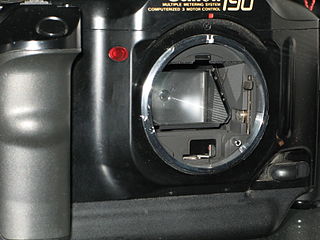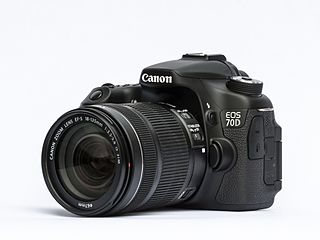Related Research Articles

The EF lens mount is the standard lens mount on the Canon EOS family of SLR film and digital cameras. EF stands for "Electro-Focus": automatic focusing on EF lenses is handled by a dedicated electric motor built into the lens. Mechanically, it is a bayonet-style mount, and all communication between camera and lens takes place through electrical contacts; there are no mechanical levers or plungers. The mount was first introduced in 1987.

Sigma Corporation is a Japanese company, manufacturing cameras, lenses, flashes and other photographic accessories. All Sigma products are produced in the company's own Aizu factory in Bandai, Fukushima, Japan. Although Sigma produces several camera models, the company is best known for producing high-quality lenses and other accessories that are compatible with the cameras produced by other companies.

The Canon FD lens mount is a physical standard for connecting a photographic lens to a 35mm single-lens reflex camera body. The standard was developed by Canon of Japan and was introduced in March 1971 with the Canon F-1 camera. It served as the Canon SLR interchangeable lens mounting system until the 1987 introduction of the Canon EOS series cameras, which use the newer EF lens mount. The FD mount lingered through the release of the 1990 Canon T60, the last camera introduced in the FD system, and the end of the Canon New F-1 product cycle in 1992.
A kit lens is a "starter" lens which can be sold with an interchangeable-lens camera such as a single-lens reflex camera. It is generally an inexpensive lens priced at the lowest end of the manufacturer's range so as to not add much to a camera kit's price. The kit consists of the camera body, the lens, and various accessories usually necessary to get started in SLR photography. A kit lens can be sold by itself outside of a kit, particularly the ones that are moderately expensive; for instance a kit lens included in a prosumer SLR kit is often marketed as an upgrade lens for a consumer SLR. In addition, retailers often have promotions of standalone low-end SLR bodies without the lens, or a package that bundles the SLR body with one or two more expensive lenses.

The EF 50mm lenses are a group of normal prime lenses made by Canon that share the same focal length. These lenses are based on the classic double-Gauss lens, with the f/1.8 being a standard six-element double-Gauss with an air gap and powers between element 2 and 3 and its faster cousins adding additional elements. The 50mm focal length, when used with a 35mm film or full-frame sensor, has been widely considered to match the perspective seen by the human eye.
The Canon EF 35mm lenses are a family of wide angle prime lenses with EF mount made by Canon Inc. The family also includes one EF-S lens that only mounts on Canon bodies with APS-C sensors.

Tamron Co., Ltd. is a Japanese company manufacturing photographic lenses, optical components and commercial/industrial-use optics. Tamron Headquarters is located in Saitama City in the Saitama Prefecture of Japan.

The Pentax K-mount, sometimes referred to as the "PK-mount", is a bayonet lens mount standard for mounting interchangeable photographic lenses to 35 mm single-lens reflex (SLR) cameras. It was created by Pentax in 1975, and has since been used by all Pentax 35 mm and digital SLRs and also the MILC Pentax K-01. A number of other manufacturers have also produced many K-mount lenses and K-mount cameras.

The Canon EF 28–135 f/3.5–5.6 IS USM is a "standard" zoom lens that was introduced in February, 1998. The lens has a 4.82x zoom range and is based on the EF Lens Mount and works with all film and digital EOS cameras that support this mount.

The EF 85mm lenses are a group of medium telephoto prime lenses made by Canon Inc. that share the same focal length. These lenses have an EF type mount that fits the Canon EOS line of cameras.
The EF 24–105mm f/4L IS USM is an EF mount wide-to-telephoto zoom lens. It was introduced by Canon in 2005 to complement the well-regarded 17–40mm f/4L USM and 70–200mm f/4L USM.

Originally produced as Konica Minolta AF Zoom DT 18-200mm f/3.5-6.3 (D) by Konica Minolta in 2005, and currently produced by Sony, the Sony α DT 18-200mm f/3.5-6.3 (SAL-18200) is compatible with cameras using the Minolta A-mount and Sony A-mount lens mounts. The DT designation means this lens is designed to be used with a camera with an APS-C size sensor. When the 1.5× crop factor is considered, the lens has an effective equivalent 27–300mm focal length. The lens is derived from the Tamron AF 18-200mm f/3.5-6.3 XR Di II LD Aspherical [IF] (models A14M/A14S).
The Canon EF-S 18–135mm lens is a standard to short telephoto telezoom for Canon digital single-lens reflex cameras with an EF-S lens mount. The field of view has a 35 mm equivalent focal length of 29–216mm. With its 7.5× zoom range, it is placed into the superzoom category. Canon offers further lenses with even higher zoom ranges, such as the EF-S 18–200mm lens.

The Fujifilm X-mount is a type of interchangeable lens mount designed by Fujifilm for use in those cameras in their X-series line that have interchangeable-lenses. These lenses are designed for 23.6mm x 15.6mm APS-C sensors.

Canon EOS M is the first mirrorless interchangeable-lens camera produced by Canon.

The Canon EOS 70D is a digital single-lens reflex camera by Canon publicly announced on July 2, 2013 with a suggested retail price of $1,199. As a part of the Canon EOS two-digit line, it is the successor to the EOS 60D and is the predecessor of the EOS 80D.
The Tamron AF 18-200mm F/3.5-6.3 XR Di II LD Aspherical [IF] Macro is a superzoom lens by Tamron, initially announced in 2005. A year later, Tamron announced the Tamron AF 18-250mm f/3.5-6.3 Di II LD Aspherical [IF] Macro with a slightly larger zoom range. However, in 2008, the 18-200 model was re-released with a built-in motor for Nikon bodies lacking a motor in the body - at that time the Nikon D40, D40x and D60.
The Tamron AF 18-270mm F/3.5-6.3 Di II VC LD Aspherical (IF) MACRO is an interchangeable superzoom camera lens for Canon EF-S and Nikon F APS-C bodies, announced by Tamron on July 30, 2008. Less than two years later, it was succeeded by the more compact Tamron 18-270mm F/3.5-6.3 Di II VC PZD.

The Canon RF lens mount is an interchangeable-lens mount developed by Canon for its full-frame mirrorless interchangeable-lens cameras, and featured first by the EOS R, followed by the EOS RP. The RF mount was announced in September 2018. In May 2022 Canon announced APS-C EOS R cameras and RF-S lenses designed for these cameras.